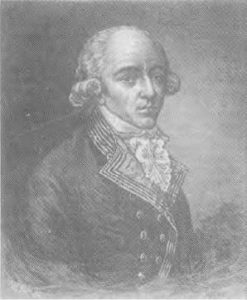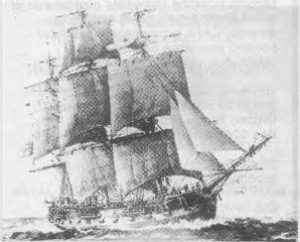- Author
- Darling, Sylvia M.
- Subjects
- Biographies and personal histories, History - pre-Federation
- Tags
-
- RAN Ships
- None noted.
- Publication
- June 1990 edition of the Naval Historical Review (all rights reserved)
Quite a number have heard about it, but not many have seen it, said my hostess as we drove over the crest of a hill in a heavy squall to park by the outer stone walls of the ancient grey stone Parish Church of St. Nicholas at Bathampton, its clock chiming the passing hours.

We made our way through the porch of the south aisle of the church and there, facing us, was a plaque in the floor on the grave of Arthur Phillip, Founder of Australia and First Governor of New South Wales! The plaque itself bore the following inscription:
“Underneath lie the Remains of ARTHUR PHILLIP Esq. Admiral of the Blue who died 31st August 1814 in his 76th year Also of ISABELLA Relict of the above Admiral Phillip who died 4th March 1823 in the 71st year of her Age.”
Each year on the 11th October at 11.30 a.m. a wreath-laying ‘Phillip of Australia Commemoration Service’ is held in the Australia Chapel of St. Nicholas. It is attended by the High Commissioner for Australia and representatives of the Australian States, as well as everyone in the parish. The service for 1988 was very special as the actual 200 years of the founding of Australia were celebrated.
It seemed that this memorial in the Australia Chapel was a fitting remembrance of the just, wise, compassionate and honest Captain Arthur Phillip, a skillful navigator and a man with a vision, who sailed in HMS SIRIUS at the head of his gallant little fleet of only 11 ships and one thousand souls from Portsmouth to Botany Bay in eight months, with fewer than 40 deaths on the voyage. (The Second Fleet had 273 die on the voyage out of approximately the same number).
There is in the records an undated paper in Phillips handwriting (his manifesto, written before sailing) in which he isolates the two great problems of the voyage – discipline and health – wrote M. Barnard Eldershow in his ‘Phillip of Australia’.
The description of Captain Phillip as a man with a vision was borne out by Biographers Louis Becke and Walter Jeffery who wrote, ‘He was the first man to believe in the future of Australia as a white nation while it was still unreasonable to believe…. Australia is his monument, in that because of his courage and loneliness he gave the whole of his mind and the whole of his personality to his work’.

It was therefore understandable that Captain Phillip’s health became so poor that he sailed home to England in 1792, arriving in May the following year. After a short stay in Bathampton he settled in Bath in his four-storeyed home at 19 Bennett Street with Mrs Phillip, his devoted wife (formerly Miss Isabella Whitehead, only daughter of Richard Whitehead of Lancashire) whom he married in 1794 following the death of his first wife two years previously. He was created a Vice-Admiral shortly after his return to England and a full Admiral towards the end of his life. While it is reasonable to suppose, in view of his ill-health, that the circle of the Admiral and Mrs Phillip’s frequently visiting friends would be narrow, it is certain that every door would have been open to him had he chosen to join in fashionable Bath society, being an Admiral and a man of distinction.
Fourteen years later, in February 1808, the Admiral suffered a stroke, but he recovered sufficiently to visit friends with Mrs Phillip in October the following year and to spend a month with friends in Oxford. Then in 1811 the Admiral and Mrs Phillip spent two months with friends at seaside Clifton. Three years were to pass when Admiral Phillip died at home on 31st August, 1814.
A simple entry in the Register of the Parish Church of Saint Nicholas, Bathampton, reads:
ARTHUR PHILLIP Bennet St., Bath. 76 years. Thos. Hale. Curate. Some eighty-three years were to pass before any real interest in Admiral Phillip’s achievement started, when in 1897 the NSW Government made enquiries in the main Bath area as to the burial place of Arthur Phillip. Then on 27th November that year the Vicar of Bathampton, Lancelot J. Fish, wrote a letter to The Times newspaper referring to the entry in the Bathampton Burial Register and of his discovery of the grave of Arthur Phillip in the Church of St. Nicholas, and argued that there should be a more worthy memorial to the first Governor of New South Wales. The Times published the letter on 2nd December, 1897, but nothing appeared to have been done at that time.




